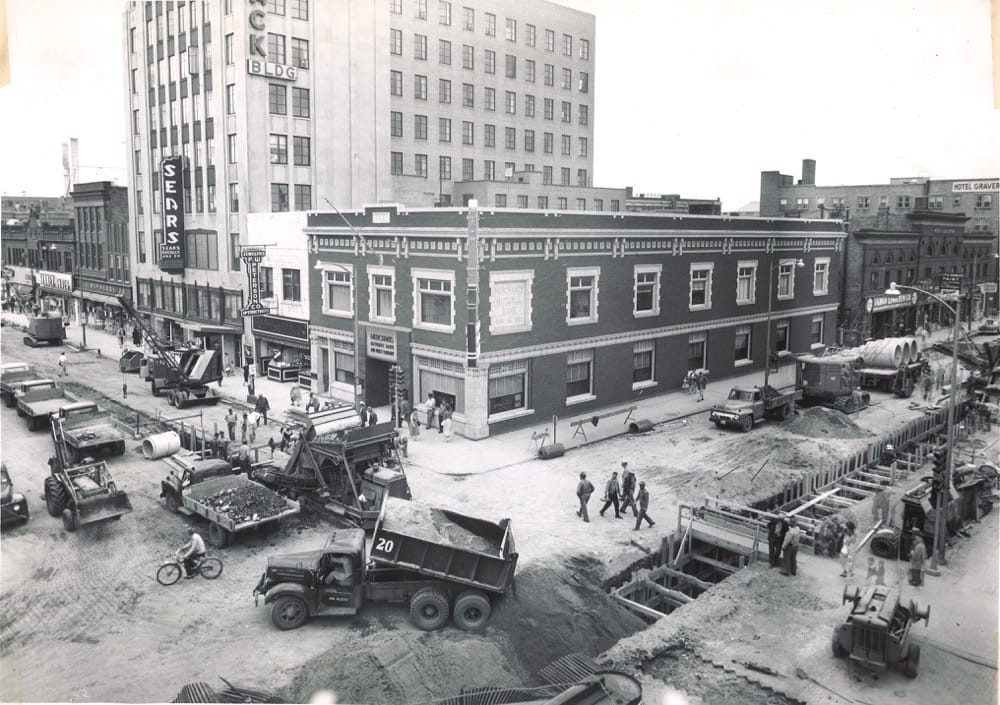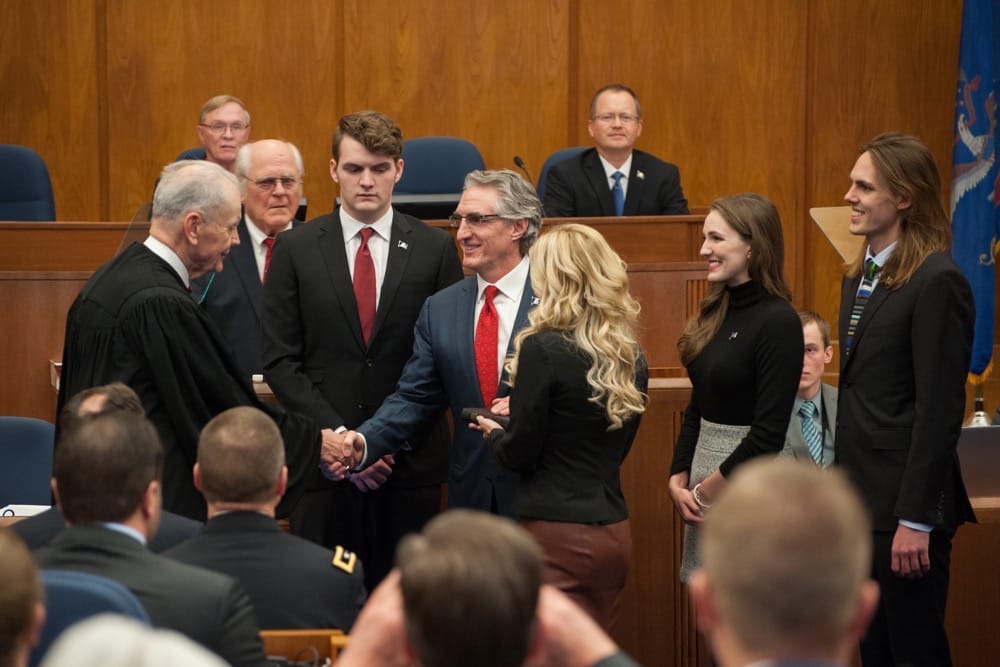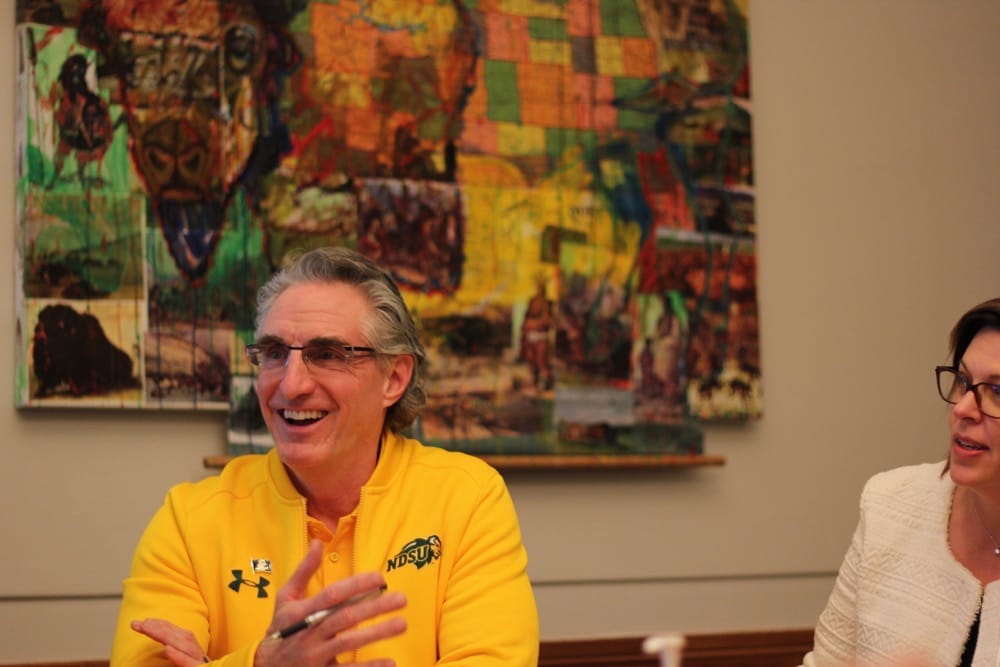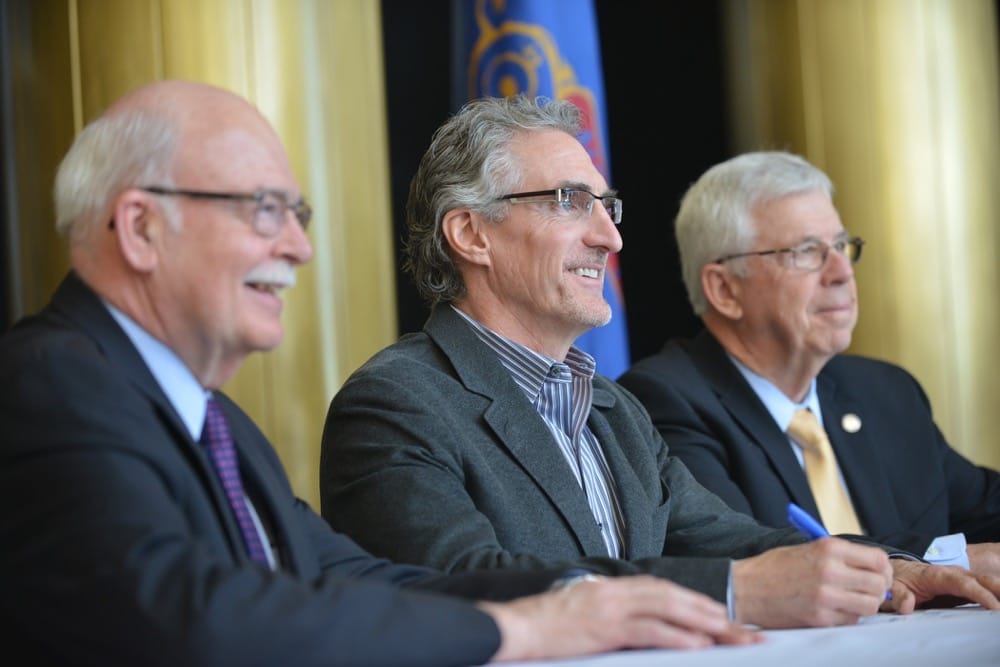Photo courtesy of J. Alan Paul Photography, the Governor’s Office and City of Fargo Engineering Department
Last December, Governor Doug Burgum officially celebrated one year in the role. The Arthur, N.D., native spent most of his adult life in Fargo. This time obviously had a lasting impact on him that he’s brought to the governor’s office. We met with Governor Burgum to discuss what he’s taken from his time in Fargo, how the rest of North Dakota feels about the Main Street Initiative and what’s the status of the diversion.

Q: You’ve obviously taken a lot from your experience in Fargo to the governor’s office. What exactly did you learn from Fargo that you’re applying state-wide?
A: My dad was born in Arthur at home in 1917. My mom was born in 1915. World War II got in the way of them having a family so they were quite old when they had kids. It sort of skipped a generation. It’s sort of unusual to have a 41, going on 42-year-old mother back in those days.
What that meant though was that my mom graduated from NDSU in ’37, which meant she graduated from high school in ’33. She was a Fargo girl and she grew up at 1114 N. 4th Street, a house that’s still there just north of Sanford. They had one high school, the Central High School, which was down on the block where the juvenile center is across from the courthouse. There were a courthouse, jail and Central High School all in that same civic area down there. She went to school. She walked, rode her bike or, in those days, they had the trolley. If it was cold, they’d sometimes spend a dime or whatever it was to ride the trolley. She grew up during a time when it (downtown) was very vibrant. Even when the Great Depression was happening, the Black Building was being built.

You fast-forward 40-some years to when I was in high school and I’m coming into the Black Building once a month to get my braces tightened by Dr. Slovinski who was an orthodontist in the Black Building. I’m driving in from Arthur. That was the time they were starting to have the decline of downtowns – the interstate system is built, things start moving out to the edge.
Even though she’s been in Arthur for decades and decades by that point in time and was very engaged in Arthur, she still had this childhood memory of vibrant Fargo in the ’20s and ’30s when she was at NDSU. That’s where she met my dad. When a store closed on Broadway, for her, it was a personal thing because she would say, ‘When we were cold and walking home in the wintertime, they’d let us step in and warm up.”
There was manufacturing going on downtown. There are very few remnants of that left. There’s only a couple of actual manufacturing – the steel plant and the guys who are doing the wood frame manufacturing west of NDSU downtown. Downtown was full of actual, what you would think of, as value added manufacturing jobs. You had the civics elements with city hall, all the faith-based – there was no such thing as suburban churches, all the churches were downtown. You had, basically, everything happening in one spot. Then you had youth and adults and all kinds of mixes of people and income, new Americans. She grew up in a Downtown Fargo that was super vibrant. I think she helped me understand from a perspective directly from those trips to the orthodontists that the Downtown Fargo is in decline and this is what it was.
I must have sort of buried that seed away and went off and got involved in tech and software. I wasn’t really thinking about the economics of cities. We had in our mind an idea that was around Apple, Silicon Valley and suburban. The word corporate campus meant that we needed to have childcare and workout facility, our own library, big cafeteria facilities, meeting rooms and all of the little things you have to do to support yourself when you’re self-contained. Of course, you fast forward to today and many of the tech companies that build campuses are scrambling to build office space in the core of downtown. Whether it’s Microsoft opening up a space in Downtown Seattle, Amazon, Twitter, Uber, Atlassian. When they’re looking for space, they’re looking for space that’s in an urban center and in the core of downtown, not the suburban model because that’s where the jobs want to go. When you do that, then you’re using the vibrant downtown as all the corporate amenities that you might have built if you were doing a suburban campus. You’re seeing this move back to the core. It’s sort of a back to the future thing.

When you say, ‘What has Fargo taught me?’ Part of what Fargo has taught me is a little bit about what my mom taught me from the ’20s and ’30s. I’ve got an understanding that that was a model that also really worked for taxpayers because when you have mixed-use concentrated on a small amount of infrastructure, it’s easier for fire, police, all of the things that taxpayers pay for – fewer water towers, less of everything. This idea that financial solvency and having a smart infrastructure that’s easy on the taxpayer, those designs existed. It’s just a question of getting back to those designs that we’ve had years ago.
But, it also ties back to what I talked about with these corporate headquarters. It also teaches me that if we want to solve workforce issues, we have to have vibrant communities where we can attract young talent to move to, we can be attractive to people who have families and want to put their roots down. It’s also that you have to be attractive to the retiring baby boomers because that’s part of the workforce.
If everybody hits 55 and decides they want to go to a sand state – sand states being California, Nevada, Arizona, Texas or Florida. That’s another leakage on the workforce. Here we are as a state with about 13,000 jobs open, one thing I saw was that there were 5,000 or 6,000 or more jobs open in the Fargo metro area. A big portion of the jobs open in the state are in the Fargo metro. We need to make sure that we have communities that can retract and retain a 21st-century workforce. Fargo has done a lot of the things that make it attractive for capital and make it attractive for an organization like Sanford to invest $500 million into a new facility and add thousands of jobs.
There are elements that have to be in place for people to make those kinds of investments. Microsoft adding hundreds of new jobs or John Deere having what they’re doing with 800 some employees. Plus, all the entrepreneurs in the tech community. It all ties together.
I would say that when I see Fargo on these lists with Austin and Seattle, as 10 cities that are attracting millennials, I think that is a super important sign for North Dakota’s economic future. The jobs for 21st-century is not so much state by state but city by city. You have to have the right framework within a positive business plan in the state, but, at the end of the day, corporate headquarters choose a city within the framework of the state. If somebody chooses where to live, they might choose the city, even more than the state.
We have to have vibrant communities and cities if we’re going to be competitive. It’s a long answer to what’s Fargo taught me. It’s essential to our competitiveness as a state in the new economy.
Q: With the Main Street Initiative, it’s often Fargo and the rest of North Dakota’s agricultural background and rural setting. How are other cities in the rest of the state adopting the main street philosophy?
A: You mentioned the rural economy, something that we’ve had since the 1900s, the agriculture in our state has been so productive. We’re producing record amounts of everything. We rank in the top five states by production for more than 10 crops. We’re doing that with fewer and fewer people all the time. Part of the reason farm size has gotten larger and farm families have gotten smaller, those are the demographics of productivity. American farmers and North Dakota farmers, in particular, are super efficient. We continue to have this demographic challenge where there have been fewer and fewer jobs in the rural areas but that’s not a new thing. That’s been going on since the 1900s. As we continue to see the metro areas continue to grow more than most of the rural areas, we still need to have communities across the state that can act as those market centers that can support those rural areas. We need a network of complementary vibrant communities across the state.
We’re not talking thousands of communities. There’s less than 60, I think it’s 55 communities, that have more than 1,000 people. I got a chance to get to every single one of them during the campaign, plus all the county seats, and we have a number of county seats that have less than 1,000 people. I think we’re down to about 178 school districts. Everybody has a unique set of assets and a unique set of interests on what they want to do. Some of those assets in the community and some of the surrounding areas in the rural areas have great natural resources, not just farming, but hunting, fishing, outdoors and access to all the beautiful places in our state. That’s very appealing to some people. Everybody has to build on their strengths.
Q: Two of the biggest problems facing Fargo-Moorhead are workforce and the diversion. You’ve been meeting with Governor Dayton. Give us an update on where everything is at and where it was left off.
A: The project was stalled. It was seven or eight years of effort and funding secured and fantastic support from the local communities, in terms of voting and infrastructure sales taxes and achieving federal authorization, which was a huge hurdle to get included in federal spending bills. It was huge financial support from the state of North Dakota, financial support from the state of Minnesota. All of that was a big effort and heroic achievement.
At the end of the day, we came up short of having a permit from the Minnesota DNR and the whole project just stalled with so much at stake. We do have the Fargo-Moorhead-West Fargo-Dilworth-Bora, the whole area’s, support. This is a huge economic engine for this region. This is very important for the state of North Dakota. Cass County has about 17 percent of the sales tax in the state and probably close to that in the number of jobs. If you take a look at the assets that have been put publicly, whether it’s an entire university or whether it’s Sanford’s new hospital, Essentia’s new expansion, take anything there and you’ve got one of the largest property tax basis in the region and all of it, by the nature of geography, it’s all in the floodplain at some point. The whole city is basically in the floodplain, including West Fargo if we have the big one.
What people found out in Grand Forks is that it’s not just living along the river in the low spots, you lose the city and the infrastructure. Grand Forks’ population, I think, is finally past where it was in 1997. It was catastrophic in terms of billions of dollars of economic loss and damage. It’s an unacceptable risk for the state and region to not have flood protection. I think there’s a general agreement on the need for flood protection and, obviously, the public supports it by passing the votes but it’s trying to navigate the politics of permitting.
With this process this fall and with the strong support of Governor Dayton, we named eight people from North Dakota and eight people from Minnesota and we met with five full-day meetings. Everybody attended every meeting. The governor from Minnesota was at every meeting the whole day and he brought with him the head of the DNR, the deputy, the engineer so we had really strong engagement of people from all sides. What we were trying to achieve was collaboration versus litigation, I guess would be the headline. We had a bunch of people in the room who all agreed to stop the legal action against each other and get around a table and talk about solutions.
We made some really good progress during those meetings. We’re going to issue a final report soon from that. What’s been even more exciting is that, since we’ve wrapped up our final meeting in mid December, a technical advisory group, which was an offshoot of that, has continued to take the input from the task force and I think is making really good progress of coming up with a solution with the engineering changes that would allow us to meet the Taskforce objectives, which were getting certifiable, 100 percent flood protection.

The key when I say certifiable is that would be in the eyes of FEMA because without that, we could have more than 10,000 homeowners in Fargo, Moorhead and West Fargo that would be buying flood insurance at four grand a year or higher. Now that we’ve had both Harvey and the Florida hurricane, the federal flood insurance is so tapped out, if they’re going to raise their rates actuarially sound, you could see rates being $4,000 on a $200,000 house annually. That could double if they wanted to make it actuarially sound and not subsidize it. Even without a flood, the flood insurance could kill the housing market in a community where we’ve got 6,000 or 7,000 jobs.
The risk isn’t just the flood. The risk is the economic catastrophe that goes along without having flood protection. There is no high ground. It’s not a, ‘Let’s all move up on the hill.’ This is, essentially, the majority of the metro area is in the floodplain. It’s paramount that we come up with a solution. This Taskforce, the technical advisory group is making really strong progress and I think we’re going to see some information from them in the coming weeks that would actually allow us to have the 100-year flood protection. It’s certifiable, we maintain federal authorization and we manage the downstream and upstream impacts, we get water off of Minnesota, we get water out of Wilkin and Richland counties. We sort of solved all the objectives we set out to do, which was the act of the impossible because, in some ways, it was impossible to solve all of these equations simultaneously. I’m optimistic that we’re going to get there and get this project moving again.
Q: On another note, it amazes me how much resources are out there for the citizens of North Dakota, being relatively new to the government and politics, have you discovered any resources that the state offers to entrepreneurs or whatever the sector might be until you took the office?
A: Given my long tenure in the private sector and given the fact that for 33 years, I was either building companies, attracting capital and hiring people. I had a pretty good sense of all the different tools that were available. I think that North Dakota and a number of programs that exist through either the Department of Commerce or through the Bank of North Dakota, there’s a lot of solutions or programs that have been created to solve problems that face North Dakota.

One of the classic problems we have in North Dakota is lack of capital. We have great people with great ideas and they end up leaving the state because they can’t get the capital in order to pursue their idea. Then, there are some cases where we’ve had regulations that would prevent the formation of capital and we need to keep chipping away at because we want to make sure that entrepreneurs and innovators, if they want to build a company here, they need talent and you need capital.
Both of those things are a little bit scarce, but one of the things that have been proven by other entrepreneurs is that if you got a great business idea, you can not only attract people to stay here, you can attract people to move back to North Dakota or to move from someplace else to North Dakota because the quality of life that we have here.
Again, attracting capital and people are always something that we need to keep focused on. We also don’t do anything that restricts the private sector from just operating and having those two mechanisms work well at all times.
*This article originally appeared in Fargo By Fargo.








